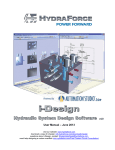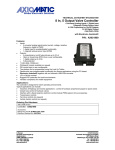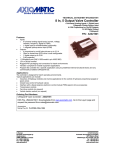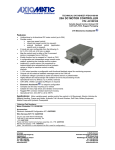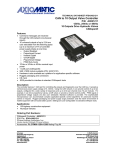Download EVDR9-10 Application Guide
Transcript
Application Guide Introduction to the EVDR9 and EVDR10 About this Document This document is an introductory Application Guide for the EVDR9 and EVDR10 J1939 modules from Hydraforce. More specifically, this guide provides only a basic introduction to the usage and configuration of the modules for simple applications. More thorough information can be found in the Technical Manuals available from Hydraforce. This guide assumes the user has some background in electronics and is familiar with the basics of J1939. For a good introduction to J1939, consult the application note “Introduction to J1939”, number AN-ION-1-3100, available from Vector Informatik. EVDR9 The EVDR9 is a nine-output J1939 slave module. It has nine outputs that can be individually configured to any of the following types: • On/Off • Hot-shot current-limited on/off • Proportional current • Proportional voltage • PWM duty cycle The outputs of the EVDR9 are controlled by messages received on the J1939 bus. Configuration of the EVDR9 will be explored later. EVDR10 The EVDR10 is a ten-input J1939 slave module. It had ten inputs that can be individually configured to any of the following types: • Digital switch-to-battery • Voltage • PWM duty-cycle • 4-20 milliamp current • Resistance The EVDR10 transmits the input values onto the J1939 bus. Configuration of the EVDR10 will be explored later. Point-to-Point Configuration If an EVDR9 and an EVDR10 are connected to the same J1939 bus, it’s possible to configure them so that the EVDR10 inputs directly control EVDR9 outputs by setting the J1939 messages appropriately. To link an EVDR10 input to an EVDR9 output, the user must configure the EVDR9 output to respond to the message that the EVDR10 is sending out. Specific examples of this will be explored later. Configuration The EVDR9 and EVDR10 are configured using Electronic Assistant, a software tool available from Hydraforce. Also required is a USB-CAN converter, available from Hydraforce. A Screenshot of Electronic Assistant is shown in Figure 1. The modules are configured over the J1939 link. When the software connects, all modules on the J1939 bus are shown and can be individually configured. ©2008 HydraForce Inc. Page 1 PRELIMINARY Rev. B Application Guide FIGURE 1: Electronic Assistant J1939 The EVDR10 takes readings from its inputs and converts them into data that is sent out onto the J1939 bus. The EVDR9 takes data from the J1939 bus and controls its outputs accordingly. The data on the J1939 bus is encapsulated within a J1939 message. The user has full control, through Electronic Assistant, over how the data is scaled and stored in the message. ©2008 HydraForce Inc. Page 2 PRELIMINARY Rev. B Application Guide Figure 2 shows the operation of the EVDR9 and EVDR10. Both modules operate as a bridge between the input or output devices and the J1939 bus. Each input on the EVDR10 is configured to take a reading (e.g. 0V – 5V), scale the value to a normalized scale (e.g. 0.0 – 100.0), and embed that value into a J1939 message that is transmitted onto the bus. Similarly, each EVDR9 output is configured to look for a specific message on the J1939 bus. When it receives the message, it takes the data embedded in it (e.g. 0.0 – 100.0), scales it to the appropriate range (e.g. 0.0A – 2.0A), and activates the output accordingly. One of the benefits of this design is that an EVDR9 and EVDR10 on the same J1939 bus can be configured so that the EVDR10’s inputs directly control the EVDR9’s outputs. EVDR10 Read Input Scale 0.0V J1939 Xmit B u s 5000 J 1 9 3 9 5.0V 0 EVDR9 J1939 Recv 2.0A Scale Send to Output J 1 9 3 9 B u s 5000 0 0.0A FIGURE 2: EVDR9 and EVDR10 Operation ©2008 HydraForce Inc. Page 3 PRELIMINARY Rev. B Application Guide Sample Application #1 – Proportional Input Controlling Proportional Output This example will demonstrate how to configure an EVDR10 input to read a 0V – 5V signal, such as a potentiometer, and use it to control a solenoid connected to an EVDR9 output. Figure 3 shows the desired current control profile. EVDR9 Output (Amps) 2.5 2 1.5 1 0.5 0 0 1 2 3 4 5 EVDR10 Input (Volts) FIGURE 3: Desired Current Profile First, the EVDR10 input is configured. To configure the input, select it in Electronic Assistant to bring up its parameters. Table 1 shows the parameters and their settings. For this example, the EVDR10 is configured to read the 0V – 5V input, scale it to a 0 – 5000 range with 0.001 V resolution, and transmit it using the PGN 65280 (0xFF00). Parameter Input Sensor Type Setting 1 (0 – 5V) Filter Type Transmit PGN 0 (Not Used) 65280 (0xFF00) Repetition Rate 50 ms Proprietary B Message Type 1 (Command) Data Size Data Index 2 (Word) 2 Data Resolution 0.001 V/bit ©2008 HydraForce Inc. Definition This is the type of input being used. Available Input types include 0-5V, 0(4)-20mA, Digital High, PWM, Frequency/RPM and 16Bit Counter. Filtering will not be used. This is the PGN of the J1939 message assigned to this input. 65280 is the first PGN in the Proprietary B range. To maintain J1939 conformance, it is recommended to use only Prop B PGN’s in the range of 65280 – 65535. This is the rate at which the message is transmitted. The fastest recommended rate is 20 ms. This setting causes the EVDR10 to send the data in a Command Message. In a Command Message, the first byte sent is 0x0C, the next is an enable byte, and the next two are the data. The EVDR9 will read and interpret this message. The data will be 2 bytes (16 bits) long. The data starts on the 3rd byte, with the first byte designated byte 0. Data in the J1939 message will represent mV. Page 4 PRELIMINARY Rev. B Application Guide Offset 0.00 V There is no offset required. Generate Diagnostic Messages FALSE Setting this to TRUE would cause the EVDR10 to generate J1939 compliant diagnostic messages when an error occurs at the input. The remaining parameters all associate with this one so there is no need to set them. TABLE 1 Table 2 shows the parameters for the EVDR9 output that is configured to respond to the EVDR10 input above. Parameter Output Type Setting 1 (Proportional Current) Output at or below Minimum Command Output at Breakpoint 0 ma Output at or above Maximum Command Ramp Up 2000 ma Ramp Down 0 ms Dither Frequency Dither Amplitude Command PGN 100 Hz 150 ma 65280 (0xFF00) Response Sent 0 (No Response) Command Message Timeout 200 ms Proprietary B Scheme is Used Minimum Command TRUE Breakpoint Command 2.5 (V) Maximum Command 4.5 (V) Command Data Size Command Data Index Command Data Resolution Command Data Offset 2 (bytes) 2 0.001 (V/bit) This is the PGN of the J1939 message that controls this output. This is set to the same PGN as the EVDR10 input configured before. The EVDR9 can be set to send an acknowledge message. In this case it’s not required. If the EVDR9 doesn’t receive the command message after 200 ms, it will turn off this output. The EVDR10 was configured to transmit the message using this scheme. This is the input value that corresponds to Minimum Output, configured above. This is the input value that corresponds to Breakpoint Output, configured above. It is set to be in the middle. This is the input that corresponds to Maximum Output, configured above. Same as EVDR10 Same as EVDR10 Same as EVDR10 0.0 0.00V Same as EVDR10 Same as EVDR10 ©2008 HydraForce Inc. 1000 ma 0 ms 0.5 (V) Definition This is the output being used. Available outputs include: Proportional Current, Proportional Voltage, Digital On/Off, Hotshot Digital and PWM Duty Cycle This is the output current at or below the Minimum Command, defined below. A breakpoint allows for a current profile with two different slopes. In this case, there is no need for it, so the breakpoint is set in the middle. This is the output current at or above the Maximum Command, defined below. Ramps are turned off, but can be set higher to provide soft shifting. Ramps are turned off, but can be set higher to provide soft shifting. Page 5 PRELIMINARY Rev. B Application Guide TABLE 2 Sample Application #2 – Digital Input Controlling Digital Output This example will demonstrate how to configure a switch connected to the EVDR10 to activate a solenoid connected to the EVDR9. Table 3 shows the EVDR10 input settings, and Table 4 shows the EVDR9 output settings. Parameter Input Sensor Type Setting 6 (Digital High) Transmit PGN 65280 (0xFF00) Repetition Rate 50 ms Proprietary B Message Type 1 (Command) Data Size Data Index 2 (Word) 2 Data Resolution Offset Generate Diagnostic Messages 1.0 State/bit 0.00 V FALSE TABLE 3 Definition This is the type of input being used. The EVDR10 only supports Switch-to-Battery type inputs. This is the PGN of the J1939 message assigned to this input. 65280 is the first PGN in the Proprietary B range. This is the rate at which the message is transmitted. The fastest recommended rate is 20 ms. This setting causes the EVDR10 to send the data in a Command Message. In a Command Message, the first byte sent is 0x0C, the next is an enable byte, and the next two are the data. The EVDR9 will read and interpret this message. The data will be 2 bytes (16 bits) long. The data starts on the 3rd byte, with the first byte designated byte 0. Data in the J1939 message will represent state. There is no offset required. Setting this to TRUE would cause the EVDR10 to generate J1939 compliant diagnostic messages when an error occurs at the input. The remaining parameters all associate with this one so there is no need to set them. Parameter Output Type Command PGN Setting 3 (On/Off Digital) 65280 (0xFF00) Response Sent 0 (No Response) Command Message Timeout Proprietary B Scheme is Used Minimum Command 200 ms Maximum Command Command Data Size Command Data Index Command Data Resolution Command Data Offset 1 2 (bytes) 2 1.0 Definition This is the output type being used. This is the PGN of the J1939 message that controls this output. This is set to the same PGN as the EVDR10 input configured before. The EVDR9 can be set to send an acknowledge message. In this case it’s not required. If the EVDR9 doesn’t receive the command message after 200 ms, it will turn off this output. The EVDR10 was configured to transmit the message using this scheme. This is the input value that corresponds to Output ON. This is the input that corresponds to Output OFF. Same as EVDR10 Same as EVDR10 Same as EVDR10 0.0 Same as EVDR10 ©2008 HydraForce Inc. TRUE 0 Page 6 PRELIMINARY Rev. B Application Guide TABLE 4 Sample Application #3 – Proportional Input Controlling Digital Output This example will show how to configure a proportional input to trigger a digital output, such as a pump enable when the input exceeds a certain threshold. Figure 4 shows the desired response. The EVDR9 output is to turn on when the EVDR10 input exceeds 1.5 volts. EVDR9 Output (Amps) 2.5 2 1.5 1 0.5 0 0 1 2 3 4 5 EVDR10 Input (Volts) FIGURE 4: Desired Current Profile In this case, the EVDR10 input will be configured the same as in Sample 1. Consult Table 1 for the parameter settings. The voltage measured at this input is transmitted in mV. The EVDR9 output is configured as shown in Table 5. Parameter Output Type Command PGN Setting 3 (On/Off Digital) 65280 (0xFF00) Response Sent 0 (No Response) Command Message Timeout Proprietary B Scheme is Used Minimum Command 200 ms Maximum Command 1550 (mV) Command Data Size Command Data Index Command Data Resolution 2 (bytes) 2 1.0 ©2008 HydraForce Inc. TRUE 1450 (mV) Definition This is the output type being used. This is the PGN of the J1939 message that controls this output. This is set to the same PGN as the EVDR10 input configured before. The EVDR9 can be set to send an acknowledge message. In this case it’s not required. If the EVDR9 doesn’t receive the command message after 200 ms, it will turn off this output. The EVDR10 was configured to transmit the message using this scheme. This is the input value that corresponds to Output OFF. Minimum and Maximum Command are set 100 mV apart to provide hysteresis. The command has to exceed Maximum to enable the output, and has to go below Minimum to disable the output. The hysteresis prevents the output from oscillating due to input noise. This is the input value that corresponds to Output ON. Same as EVDR10 Same as EVDR10 Same as EVDR10 Page 7 PRELIMINARY Rev. B Application Guide Command Data Offset TABLE 5 0.0 Same as EVDR10 Application guide limitations: This Application guide is a preliminary document showing specific examples of how HF intends the EVDR9 and EVDR10 to be used and operated. The input/output fields, parameter names and ranges are subject to change without notice. Although we do not foresee any performance or actual driver specifications changes, the Graphical User Interface (GUI) may change. A complete user’s manual will be written upon final release of the GUI. This document is being furnished by HydraForce Inc. for information purposes only. Information in this document is subject to change without notice and the provision of such information does not represent any commitment on the part of HydraForce, Inc. The software described in this document is furnished by Axiomatic under a proprietary license agreement. The software may be used only in accordance with the terms of that license agreement. It is against the law to copy or use the software except as specifically allowed in the license agreement. No part of this document may be reproduced in any form or by any means, whether electronically or mechanically, including, but not limited to the way of: photocopying, recording, or information recording and retrieval systems, without the express, prior, written permission of HydraForce Inc. You may not distribute, reproduce, republish, display, modify, transmit, reuse, repost, or use any portion of this document for public or commercial purposes without the express, prior, written permission of HydraForce, Inc. Training using this document may only be conducted by HydraForce Corporation or its authorized representatives. Modification of this document is a violation of HydraForce Corporation’s copyright and other proprietary rights. Written by Bernie Szwarc, and David Price. Copyright © 2005-2008 HydraForce Inc. All rights reserved. ©2008 HydraForce Inc. Page 8 PRELIMINARY Rev. B








